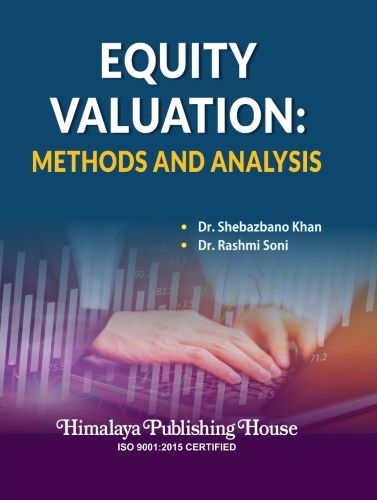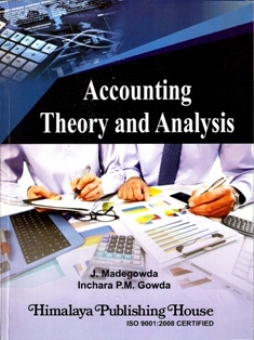Equity Valuation: Methods and Analysis is a comprehensive guide designed to equip management and finance professionals and CFA students with essential tools and techniques for evaluating equity investments. The book provides actionable insights into market trends, valuation models, and strategic decision-making by bridging theoretical frameworks with practical applications. It empowers readers to sharpen their analytical skills, enhance their financial acumen, and make informed investment decisions, opening doors to successful careers in corporate finance, investment banking, portfolio management, and equity research.
Contents –
1. DISCOUNTED DIVIDEND VALUATION
1.1 Learning Outcome
1.2 Introduction
1.3 Present Value Models
1.3.1 Valuation Using Future Cash Flows’ Present Value
1.3.2 Streams of Expected Cash Flows
1.4 The Dividend Discount Model
1.4.1 The Single Holding Period Expression
1.4.2 The Expression for Multiple Holding Periods
1.5 The Gordon Growth Model
1.5.1 The Gordon Growth Model Equation
1.5.2 The Gordon Growth Model’s Relationships Between Dividend Growth, Earnings Growth, and Value Appreciation
1.5.3 Share Repurchases
1.5.4 The Implied Dividend Growth Rate
1.5.5 The Present Value of Growth Opportunities
1.5.6 Gordon Growth Model and the Price-to-Earnings Ratio
1.5.7 Estimating a Required Return Using the Gordon Growth Model
1.5.8 The Gordon Growth Model: Concluding Remarks
1.6 Multistage Dividend Discount Models
1.6.1 Two-Stage Dividend Discount Model
1.6.2 Valuing a Non-Dividend-Paying Company
1.6.3 The H-Model
1.6.4 Three-Stage Dividend Discount Models
1.6.5 Spreadsheet (General) Modelling
1.6.6 Estimating a Required Return Using any DDM
1.6.7 Multistage DDM: Concluding Remarks
1.7 The Financial Determinants of Growth Rates
1.7.1 Sustainable Growth Rate
1.7.2 Dividend Growth Rate, Retention Rate, and ROE Analysis
1.7.3 Financial Models and Dividends
1.8 Summary
1.9 Practice Problems
2. INTRODUCTION TO FREE CASH FLOWS
2.1 Learning Outcome
2.2 Introduction
2.3 FCFF and FCFE Valuation Approaches
2.3.1 Defining Free Cash Flow
2.3.2 Present Value of Free Cash Flow
2.3.2.1 FCFF and FCFE Valuation Approaches
2.4 Single-Stage (Constant-Growth) FCFF and FCFE Models
2.4.1 Constant-Growth FCFF Valuation Model
2.4.2 Constant-Growth FCFE Valuation Model
2.4.3 Forecasting Free Cash Flow
2.5 Computing FCFF From Net Income
2.6 Computing FCFF From the Statement of Cash Flows
2.7 Noncash Charges
2.8 Computing FCFE From FCFF
2.9 Finding FCFF and FCFE from EBIT or EBITDA
2.10 FCFF and FCFE on a Uses-of-Free-Cash-Flow Basis
2.11 Forecasting FCFF and FCFE
2.12 Other Issues in Free Cash Flow Analysis
2.12.1 Analyst Adjustments to CFO
2.12.2 Free Cash Flow Versus Dividends and Other Earnings Components
2.12.3 Free Cash Flow and Complicated Capital Structures
2.13 Free Cash Flow Model Variations
2.14 An International Application of the Single-Stage Model
2.15 Sensitivity Analysis of FCFF and FCFE Valuations
2.16 Two-Stage Free Cash Flow Models
2.16.1 Fixed Growth Rates in Stage 1 and Stage 2
2.16.2 Declining Growth Rate in Stage 1 and Constant Growth in Stage 2
2.17 Three-Stage Growth Models
2.17.1 ESG Considerations in Free Cash Flow Models
2.18 Nonoperating Assets and Firm Value
2.19 Summary
2.20 Practice Problems
3. MARKET-BASED VALUATION: PRICE AND ENTERPRISE VALUE MULTIPLES
3.1 Learning Outcome
3.2 Introduction
3.3 Price and Enterprise Value Multiples in Valuation
3.4 Price and Enterprise Value Multiples in Valuation
3.4.1 The Method of Comparables
3.4.2 Price and Enterprise Value Multiples in Valuation
3.4.2.1 The Method Based on Forecasted Fundamentals
3.4.2.2 Price Multiples
3.5 Valuation Based on Forecasted Fundamentals
3.5.1 Valuation Based on Comparables
3.5.2 P/ES In Cross-Country Comparisons
3.5.3 Using P/ES to Obtain Terminal Value in Multistage Dividend Discount Models
3.6 Valuation Based on Forecasted Fundamentals
3.6.1 Valuation Based on Comparables
3.6.2 Price to Sales
3.6.3 Determining Sales
3.7 Valuation Based on Forecasted Fundamentals
3.8 Valuation Based on Comparables
3.9 Determining Cash Flow
3.10 Valuation Based on Forecasted Fundamentals
3.10.1 Valuation Based on Comparables
3.10.2 Price to Dividends and Dividend Yield
3.10.3 Calculation of Dividend Yield
3.11 Value Determination Using Predicted Fundamentals
3.11.1 Valuation Based on Comparables
3.11.2 Enterprise Value Multiples
3.11.3 Enterprise Value to EBITDA
3.11.4 Determining Enterprise Value
3.11.5 Valuation Based on Comparables
3.11.6 Other Enterprise Value Multiples
3.12 Enterprise Value to Sales
3.13 Comparison of Price and Enterprise Value Multiples
3.13.1 International Considerations When Using
3.13.2 Momentum Valuation Indicators
3.14 Valuation Indicators: Issues in Practice
3.14.1 Averaging Multiples: The Harmonic Mean
3.15 Summary
3.16 Practice Problems
4. CASE STUDIES IN VALUATION
4.1 Bharat Hotels Company.
4.2 DCF Value
4.3 Bharat Heavy Electricals Limited (BHEL)
4.4 Valuation in the Merger of TOMCO and HLL
4.5 Bhoruka Power Corporation Limited
4.6 Valuation in the Merger of ICICI with ICICI Bank
4.7 Sasken Communication Technologies
4.7.1 Sasken’s Performance
4.7.2 Comparable Companies
4.7.3 Cadmin Pharma
4.7.4 Adapted from a Valuation Report Prepared in Early 2012
4.8 DCF Valuation
4.9 Valuation of Infosys Brand
4.10 Extracted from the 2007-2008 Annual Report of Infosys Technologies
4.11 Challenges in Valuing Technology Companies
5. FREQUENTLY ASKED QUESTIONS IN VALUATION







